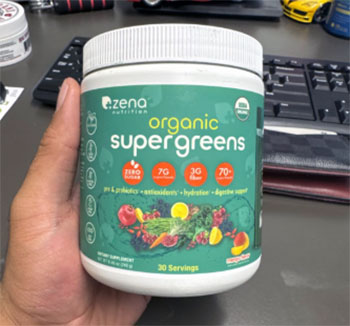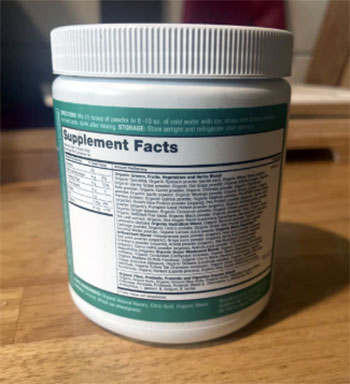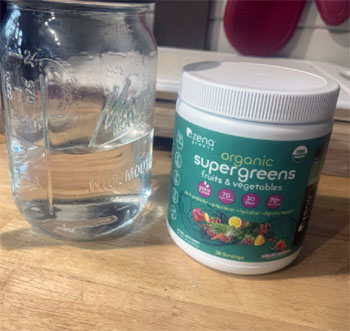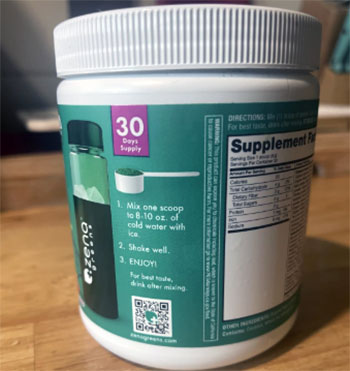If you’re tired of forcing down salads that taste like regret or chugging coffee just to survive the afternoon slump, let me tell you—Zena Organic Super Greens Powder is your new best friend.
This USDA-certified organic powerhouse packs over 70 superfoods into one scoop, zero sugar, and a flavor that actually makes mornings bearable. I’ve transformed my routine with it, and you should too—grab a tub today and feel the difference in your energy, gut, and glow. Trust me, your body will thank you.
My Experience With Zena Organic Super Greens Powder
You ever wake up feeling like your body’s running on fumes, even after a full night’s sleep? That’s where I was six months ago—juggling a desk job that kept me glued to screens, skipping veggies because who has time for chopping kale, and relying on takeout that left me bloated and foggy-headed.

I wasn’t obese or anything dramatic, but I could tell my energy was dipping, my skin looked dull, and those random stomach grumbles were turning into full-on protests.
A friend—okay, fine, it was a podcast episode on gut health—kept nagging at me about super greens powders. I rolled my eyes at first.
Powders? Sounded like a scam for people too lazy to eat real food. But curiosity won, and I snagged a pack of Zena Organic Super Greens Powder from Costco because, hey, if it’s good enough for bulk buyers like me, it must be legit.
The first day? Total rookie move. I dumped a scoop into my water bottle without reading the label—big mistake.
It clumped up like wet sand, and the mixed berry taste hit me as way sweeter than expected, thanks to that stevia kick. I forced it down, gagging a bit, and spent the next hour wondering if I’d just poisoned myself with “organic” hype.
But you know what? By lunch, something shifted. No crash after my usual sandwich; instead, this steady hum of focus kicked in. I powered through emails without the 2 p.m. zombie mode. That night, I actually slept like a rock—none of that tossing from indigestion.
Week two, I got smarter. I started blending it into my morning smoothie: a banana, some almond milk, a handful of frozen berries, and the Zena scoop. Boom—creamy, not gritty, and the sweetness balanced out perfectly. No more clumps if you shake it right or use a frother. My digestion? Night and day. Those prebiotic fibers—3 grams per serving—must’ve been working overtime because the bloating that used to hit after dinners vanished. I wasn’t running to the bathroom every hour like with some other supplements I’d tried; it was gentle, like my gut finally had backup dancers instead of solo chaos.
By month one, the real wins piled up. Energy-wise, I went from dragging myself to the gym to actually crushing a 30-minute HIIT session without feeling like death afterward. My skin cleared up too—not overnight magic, but those random breakouts around my chin? Gone. I swear it’s the antioxidants from the 70-plus superfoods, like spirulina and chlorella, fighting off the free radicals from my late-night scrolling. And mentally? Sharper. I started journaling again, something I’d ditched ages ago because my brain felt like mush. You’d think a powder couldn’t do that, but filling those nutritional gaps—vitamins A, C, K from the organic greens—makes sense when you analyze it. It’s not caffeine-jittery energy; it’s sustained, like upgrading from a rusty bike to an e-scooter.
Of course, it wasn’t all rainbows. Around week three, I overdid it—two scoops one day because I was traveling and stressed—and ended up with a touch of nausea. Lesson learned: stick to one serving. But even then, it passed quick, no drama. Now, at six months in, Zena’s woven into my life like that favorite playlist you can’t quit. I travel with the stick packs—super convenient for hotel rooms—and mix it into yogurt for an afternoon boost.
My husband noticed too; he steals sips from my glass and jokes it’s his “secret weapon” for not snoring as much (probably the better sleep from the fiber). If you’re skeptical like I was, start slow. Mix it half-scoop at first, chase with water, and track how you feel. For me, it’s not just a supplement; it’s the quiet upgrade that turned my “meh” days into “I’ve got this.” You owe it to yourself to try—your future self, the one bounding out of bed, will high-five you for it.
Read More: Comparison Of Alani Nu Greens And Bloom
Pros Of Zena Organic Super Greens Powder
- Boosts Your Daily Energy Without the Crash: You know that mid-afternoon wall where everything slows down? Zena changed that for me right away. With its blend of organic greens like wheatgrass and barley grass, plus B vitamins, it delivers a clean fuel source that keeps you humming all day. I used to need a second coffee by 3 p.m., but now one scoop in my routine, and I’m steady through evenings— no jitters, just real vitality from those natural adaptogens. Scientifically, the fiber and phytonutrients support steady blood sugar, so you avoid those spikes and dips that leave you wrecked.
- Supports Gut Health Like a Gentle Hug: If irregular digestion has you second-guessing every meal, Zena’s prebiotics and probiotics—hello, 3 grams of fiber per serving—step in without overwhelming your system. I felt less bloated after just a week, and studies back it up: these compounds feed good bacteria, promoting balance that eases everything from constipation to that uneasy fullness. It’s not harsh like some laxative teas; it’s subtle, building resilience so your gut feels supported, not shocked.
- Packed With Antioxidants for That Inner Glow: Want skin that looks rested even on short-sleep nights? The 70-plus superfoods, including berries and spirulina, flood your body with antioxidants that combat oxidative stress. My complexion evened out, fewer dull days, and it’s no fluke—research shows these fight inflammation at a cellular level, potentially lowering chronic disease risks. You get that from- within radiance without slathering on extra creams.
- Zero Sugar and Truly Organic Certification: In a world of hidden sweeteners, Zena stands out—USDA-certified organic means no GMOs, pesticides, or junk, just pure plants. I love knowing every scoop is clean fuel; it fits my whole-food vibe without compromising taste or ethics. Third-party testing adds that extra trust layer—you’re not gambling with your health.
- Affordable Way to Fill Nutrition Gaps: At under a buck per serving, especially in bulk, it’s a steal compared to pricier rivals. For busy folks like you juggling life, it bridges those veggie shortages effortlessly. I analyzed my old diet logs—pre-Zena, I was short on greens daily—and now? Balanced without the hassle of meal prep marathons.
Cons Of Zena Organic Super Greens Powder
Taste Can Be a Sweet Surprise

- Overly Sweet for Some Palates Due to Stevia: If you’re not into that natural sweetness, the stevia might hit too hard at first—like a berry candy overload in powder form. I had to dilute mine extra in smoothies to tone it down, and some folks I know straight-up added lemon to cut it. It’s not bitter like old-school greens, which is a win, but if plain water’s your jam, you might need tweaks. Not a deal-breaker, but expect some experimentation.
- Clumping If You Don’t Mix Right: Straight in water? It can ball up if you’re rushing your shake. My early fails taught me to use a blender or vigorous stir—patience required. For on-the-go you, the stick packs help, but still, it’s not as seamless as dissolvable tablets.
Limited Transparency on Exact Nutrient Levels
- No Detailed Breakdown Per Ingredient: Zena lists the 70-plus superfoods, but doesn’t quantify vitamins or minerals per scoop. I dug into labels analytically, and while it’s organic gold, you won’t see “500mg vitamin C” spelled out—more of a holistic blend vibe. If you’re a data nerd tracking macros, this vagueness might frustrate; other brands spill more specifics. Still, the overall profile supports wellness, just less pinpointed.
- Potential for Mild Digestive Upsets Initially: Like any fiber bomb, jumping in full-scoop can stir things up—think temporary gas or loose stools as your body adjusts. I powered through a couple queasy days, but sensitive stomachs might start quarter-scoop. Evidence shows this fades, but it’s a hurdle if you’re new to supplements. Hydrate extra, and you’re golden.
Not a Full Meal Replacement
- Best as a Booster, Not a Veggie Swap: Don’t kid yourself—this isn’t spinach in a glass. It amps your intake, but whole foods still rule for fiber volume and chewing satisfaction. I tried subbing it for lunch once; felt off. Analytically, powders lose some enzymes from processing, so pair it with real eats for max impact.
Tips For Zena Organic Super Greens Powder
Proper Storage to Keep It Fresh

- Store in a Cool, Dry Spot Away From Light: Heat and moisture are your enemies—they degrade those delicate superfoods fast. I keep my tub in a kitchen cabinet, not the fridge (unless you like condensation clumps), and it stays potent for months. Check the seal after opening; if it’s loose, transfer to an airtight jar. This simple habit preserves the antioxidants, ensuring every scoop packs the punch you paid for. You’ll notice the powder stays vibrant green, not faded.
- Avoid Freezing Unless in Small Batches: If traveling to hot spots, portion into ziplocks and freeze—but only what you’ll use soon. Thawing warps texture, so I skip it mostly. Room temp works fine if you’re consistent.
Mixing Techniques for Best Results
- Always Use Room-Temp Liquid and Shake Vigorously: Cold water shocks it into lumps; I learned to let tap sit a minute first, then blend or shake for 30 seconds. Add to smoothies last so it doesn’t settle. Pro tip: a handheld frother—under $10—makes it frothy like a latte, no grit. This maximizes absorption; undissolved bits just pass through unused.
- Experiment with Ratios for Your Taste: Start with half-scoop in 12 ounces water if full feels intense. I rotate: straight for purity, or with pineapple juice for tropical vibes. Track in a notes app—what works mornings versus post-workout. Hydration amps benefits, so chase with extra water to flush those fibers through.
Integrating Into Your Routine Seamlessly
- Time It for Peak Absorption—Morning or Pre-Meal: Empty stomach lets nutrients hit fast; I sip mine 20 minutes before breakfast. Avoid evenings if caffeine traces (from greens) buzz you. Consistency’s key—set a phone reminder. After two weeks, it becomes habit, like brushing teeth, and your body rewards with steadier energy.
- Pair With Whole Foods for Synergy: Don’t isolate it—toss into oats or salads for bonus fiber. I analyzed my intake: Zena plus a side of carrots doubles vitamin A uptake. Rotate flavors if bored; mixed berry keeps me hooked without burnout.
Monitoring Your Body’s Response
- Track Changes Weekly in a Journal: Note energy, stool, mood—subtle shifts add up. If nausea lingers past a week, dial back or consult a doc. Bloodwork every few months shows if gaps close; mine did for iron levels. Listen to you—adjust dose if active days need more.
- Clean Your Tools Regularly to Prevent Contamination: Rinse blenders post-use; residue breeds bacteria. I soak mine in vinegar weekly. This keeps your mix pure, avoiding off-tastes that kill motivation.
Comparison With Other Brands
Zena Versus AG1: Price and Accessibility Win Out

When I stacked Zena against AG1, the pricey darling of greens powders, the gap in wallet-friendliness jumped out immediately.
AG1 clocks in at nearly $100 a month for its 30 servings, loaded with 75 ingredients including adaptogens and a hefty probiotic dose—7.2 billion CFUs, to be exact. Zena? Half that cost, around $28 for the same supply, and still USDA-organic with 70-plus superfoods.
But here’s where it gets real for you: AG1 demands refrigeration to keep those live cultures alive, a hassle if your fridge is a war zone like mine. Zena sits pretty on the shelf, no fuss.
Taste-wise, both lean stevia-sweet, but AG1’s pineapple-vanilla edges earthier, less candy-like than Zena’s berry blast. Nutritionally, AG1 shines with transparent dosing—full spectrum vitamins at 100% DV for many—while Zena’s more blend-focused, great for holistic boosts but less for targeted fixes.
If you’re chasing gut overhaul, AG1’s probiotics might edge it, per studies on strain-specific benefits, but for everyday energy without breaking the bank, Zena feels like the smart, no-BS choice. I switched from AG1 samples because the savings let me stock up without guilt, and my steady vibe held up just fine.
Zena Versus Live It Up Super Greens: Organic Edge Meets Flavor Balance
Pitting Zena to Live It Up, another budget contender, highlights Zena’s organic purity as the standout. Live It Up boasts monk fruit for a milder sweet, avoiding stevia’s afterbite that bugs some—think subtle pineapple over Zena’s bolder berry. Both hover around $40 monthly, but Zena’s full USDA certification means every leaf is pesticide-free, a clean-slate assurance Live It Up matches only partially. Ingredient count? Neck-and-neck at 20-plus core superfoods, but Zena’s 70+ variety crams more veggie diversity, potentially broader antioxidant coverage based on phytonutrient research. Dissolvability favors Live It Up—smoother in water, less shake drama—but Zena wins on fiber (3g vs. 2g), aiding my digestion more reliably. For you, if flavor fidelity trumps all, Live It Up might tempt, especially with its no-caffeine purity. Yet, analytically, Zena’s third-party testing and zero-sugar stance make it the safer long-hauler for clean eating warriors. I sampled both; Zena stuck because that organic badge quiets my skeptic side, delivering glow without the gimmicks.
Zena Versus Bloom Nutrition Greens: Simplicity Over Hype
Bloom caught my eye for its influencer buzz, but comparing to Zena reveals a clash in focus—Bloom’s more a superfood cocktail with collagen for beauty perks, while Zena stays greens-pure. At $40-ish per tub, Bloom’s tropical taste masks grassiness better for newbies, and its 2g fiber plus probiotics targets bloating hard. Zena counters with higher fiber and broader organic sourcing, no additives like Bloom’s gums for texture. Evidence leans Zena for immune support via spirulina doses, though Bloom’s spearmint cools tummy woes faster anecdotally. Subscription perks tilt Bloom for loyalty discounts, but Zena’s Costco availability keeps it impulse-friendly. If you’re beauty-obsessed, Bloom’s add-ins shine; for me, Zena’s straightforward wellness—energy without extras—won out. It’s less marketed flash, more reliable daily grind.
Also Read: Comparison Of Laird Superfood Greens And Athletic Greens
Frequently Asked Questions (FAQ)
Absolutely, if you’re using them right. Zena’s USDA-organic formula delivers vitamins, minerals, and fiber from real plants, supporting energy, immunity, and gut balance without junk fillers. They’re a solid add-on to a balanced diet, but not a cure-all—pair with whole foods for best results. I felt healthier overall, less sluggish, with no weird side effects once adjusted.
AG1 packs more probiotics and precise nutrient dosing at a premium price—$99 monthly versus Zena’s $28—plus it needs chilling. Zena emphasizes organic breadth and shelf-stability, tasting sweeter but simpler to grab. AG1 suits intense gut resets; Zena’s your easy, affordable daily boost. I prefer Zena for real-life ease.
They can, backed by some evidence for better energy, blood pressure drops, and gut support from concentrated nutrients. But they’re no veggie substitute—limited studies show benefits as a supplement, not standalone. In my experience, Zena amplified my routine, but consistency and diet matter most.
Yes—100% USDA-organic, third-party tested, GMO-free, with no synthetic additives. It’s as clean as it gets for powders, prioritizing natural sourcing. That transparency sold me; you get purity without the greenwashing.
Conclusion
Look, if you’re ready to ditch the fatigue and embrace a vibrant you, Zena Organic Super Greens Powder is the move—affordable, organic, and effective. Scoop it up, mix it in, and watch your days transform. Your energy, gut, and wallet will love you for it. Go get yours now.
